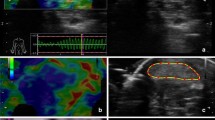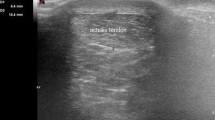Abstract
Objective
Evaluating prospectively elastosonographyc (EUS) findings of distal third of Achilles tendon in asymptomatic volunteers and correlating with subject characteristics and ultrasound (US) findings and, subsequently, calculating reproducibility of method.
Materials and methods
70 consecutives Achilles tendons were examined with US and EUS in 35 asymptomatic volunteers. Mean age 42.3 years (±7.6), 22 were female (mean age 41 ± 8.7) and 13 were male (mean age 42.5 ± 11.4). Information about population was collected (anthropometric data, sport activity, taken therapy and associated conditions/pathologies).
Results
Statistically significant correlation was found between BMI and EUS findings (p = 0.007) and between EUS aspect and US diagnosis (p = 0.039) both to the right tendon. Possible influence of smoking (p = 0.063 to right) and associated conditions (p = 0. 059 to left), has been found. The multivariate analysis showed that EUS results are correlated only with BMI (high BMI corresponds to the best EUS results), independently from smoke and associated conditions on right side. No correlations have emerged for the left tendon. The 22.8 % of the volunteers took on chronic therapies, none statistically significant correlation. In the past, 80 % of subjects played sports (7.4 % agonistic and 92.6 % non-agonistic). The 22.9 % of volunteers played sporadic or no activity. The 60 % of volunteers has played sports that may lead overload of the Achilles tendon. The 61.5 % of subjects with BMI ≥ 25 was active little or nothing; 63.6 % of the subjects with BMI < 25 is playing sports. US examination showed 57.1 % normal tendons and 42.9 % tendinosic. Rate of tendinosic tendons was similar in both left and right (40 and 45.7 %, respectively). Statistically significant correlation was found between EUS aspect and US diagnosis on the right tendon but not on the left Correlation between thickness and EUS aspect was calculated: no correlation was found. Interoperator correlation was excellent (k = 0.89 for left tendon and k = 0.91 for right tendon).
Conclusions
The EUS is an interesting and useful technique, characterised by a high reproducibility. Its results are related to BMI and US appearance of the tendon, and they are probably influenced by the smoke and associated conditions. However, the flexed ankle position, needed to properly examine the distal third by US, alters the elasticity of the tendon and causes false negative results to EUS. Then, for the EUS study of the distal third, it would be appropriate the relaxed position, with a gel pad to optimise the probe adhesion.





Similar content being viewed by others
References
De Zordo T, Fink C, Feuchtner GM, Smezkal V, Reindl M, Klauser AS (2009) Real-time sonoelastography findings in healthy Achilles tendons. AJR 193:W134–W138. doi:10.2214/AJR.08.1843
Giombini A, Dragoni S, Di Cesare A, Di Cesare M, Del Buono A, Maffulli N (2011) Asymptomatic Achilles, patellar, and quadriceps tendinopathy: a longitudinal clinical and ultrasonographus study in elite fencers. Scand j Med Sports. doi:10.1111/j.1600-0838.2011.01400.x
Öheberg L (2016) The chronic painful Achilles tendon: sonographic findings and new methods for treatment. UMEA Univerdity Medica Dissertations. New series No. 860–ISSN 0346-6612-ISBN91-7305-536-0
Maffulli N (1999) Rupture of the Achilles Tendon. J Bone Joint Surg Am 81(7):1019–1036
Holmes GB, Lin J (2006) Etiologic factors associated with syntomatic Achilles tendinopathy. Foot Ankle Int 27:952–959
Dong Q, Fessel DP (2009) Achilles tendon ultrasound technique. AJR 193:W173. doi:10.2214/AJR.09.3111
Ruan Z, Zhao B, Qi H et al (2015) Elasticity of healty Achilles tendon decreases with the increase of age as determined by acoustic radiation force impulse imaging. Int Clin Exp Med 8(1):1043–1050
Williams JGP (1986) Achilles tendon lesions in sport. Sport Med 3(2):114–135
Hoppenfeld S (1976) Physical examination of the spine and extremities. Appelton century crofts Norwalk, Connecticut
van Dijk CN, van Sterkenburg MN, Wiegerinck JI, Karlsson J, Maffulli N (2011) Terminology for Achilles tendon related disorders. Knee Surg Sports Traumatol Arthrosc 19(5):835–841. doi:10.1007/s00167-010-1374-z
Haglund P (1928) Beitrag zur Klinik der Achillessehne. Zeitschr Orthop Chir 49:49–58
Drakonaki EE, Allen GM, Wilson DJ (2009) Real-time ultrasound elastography of the normal Achilles tendon: reproducibility and pattern description. J. Crad 64:1196–1202. doi:10.1016/j.crad.2009.08.006
Tan S, Kudaş S, Özcan AS, İA, Karaoğlanoğlu M, Arslan H, Bozkurt M (2011) Real-time sonoelastography of the Achilles tendon: pattern description in healty subject and patients with surgically repaired complete ruptures. Skeleta Radiol. doi:10.1007/s0256-011-1339-4
De Zordo T, Lil SR, Fink C, Feuchtner GM, Jaschke W, Bellman-Weiler R, Klauser A (2009) Real-time sonoelastography of lateral epicondylitis: comparison of findings between patients and healthy volunteers. AJR 193:180–185. doi:10.2214/AJR.08.2020
Hartgerink P, Fessel P, Jacobson JA, van Holsbeek MT (2001) Full-versus partial-thickness Achilles tendon tears: sonographic accuracy and characterization in 26 cases with surgical correlation. Radiol 220:406–412. doi:10.1148/radiol.2202001456
Aubry S, Barbier-Brion B, Tatu L, Vidal C, Kastler B (2011) Transient elastography of calcaneal tendon: preliminary results and future prospects. J Radiol 92(5):421–427
Sconfienza LM, Silvestri E, Orlandi D et al (2013) Real-time sonoelastography of the plantar fascia: comparison between patients with plantar fasciitis and healty control subjects. Radiology 267:195–200
Landis JR, Kock CG (1977) The measurement of observer agreement for categorical data. Biometrics 33:159–174
Klauser AS, Faschingbauer R, Jaschke WR (2010) Is sonoelastography of value in assessing tendons? Semin Muscoloskelet Radiol 14(3):323–333
Kot BC, Zhang ZJ, Lee AW, Leung VY, Fu SN (2012) Elastic modulus of muscle and tendon with shear wave ultrasound elastography: variations with different technical settings. PLoS One 7(8):e44348. doi:10.1371/journal.pone.0044348
Li Y, Snedeker JG (2011) Elastography: modality-specific approaches, clinical applications, and research horizons. Skeletal Radiol 40:389–397. doi:10.1007/s00256-010-0918-0
Ooi CC, Schneider ME, Malliaras P et al (2015) Diagnostic performance of axial-strain sonoelastography in confirming clinically diagnosed Achilles tendinopaty: comparison with B-mode and color doppler imaging. Ultrasound Med Biol 41(1):15–25
Turan A, Teber MA, Ilerisoy Z et al (2015) Sonoelastographıc assessment of the age-related changes of the Achilles tendon. Med Ultrason 17(1):58–61
Hansrani V (2010) Is there a relationship between smoking and the outcomes of tendon or ligament repair and wound healing? Curr Orthop Pract 21(4):396–401
Kane SM, Dave A, Haque A, Langston K (2006) The incidence of rotator cuff disease in smoking and non-smoking patients: a cadaveric study. Orthopedics 29(4):363–366
DeZordo T, Chhem R, Smahal V, Keuchtner G, Reindi M, Fink C, Faschingbauer R, Jaschke W, Klauser AS (2010) Real-time sonoelastography: findings in patients with symptomatic Achilles tendons and comparison to healty volunteers. Ultraschall Med 31(4):394–400
Drakonaki EE, Allen GM, Wilson DJ (2012) Ultrasound elastography for musculoskeletal applications. Br J Radiol 85:1435–1445. doi:10.1259/bjr/93042867
Author information
Authors and Affiliations
Corresponding author
Ethics declarations
Conflict of interest
The authors declare that she has no conflict of interest.
Funding
None funding have this study.
Ethical approval
All procedures performed in the studies involving human participants were in accordance with the ethical standards of the institutional and/or national research committee and with the 1964 Helsinki declaration and its later amendments or comparable ethical standards.
Informed consent
Informed consent was obtained from all individual participants included in the study.
Rights and permissions
About this article
Cite this article
Capalbo, E., Peli, M. & Stradiotti, P. Sonoelastography of the distal third of the Achilles tendon in asymptomatic volunteers: correlation with anthropometric data, ultrasound findings and reproducibility of the method. Radiol med 121, 667–674 (2016). https://doi.org/10.1007/s11547-016-0642-5
Received:
Accepted:
Published:
Issue Date:
DOI: https://doi.org/10.1007/s11547-016-0642-5




